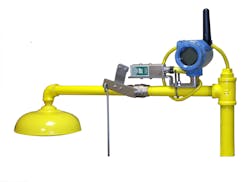Digital transformation is gaining ground in specialty chemical plants. The key enabler of this movement is the Industrial Internet of Things (IIoT), which relies on interconnected sensors, devices and other equipment to collect, analyze and transmit real-time data. For specialty chemical operations and chemical skid manufacturers, these capabilities unlock a number of benefits related to safety and efficiency.
For example, the IIoT enables operators to monitor and control processes remotely, reducing the need for human intervention, increasing worker safety and ensuring critical safety standards are being met. It also improves process efficiency, as the ability to monitor machine parameters unlocks key insights into equipment performance. Empowered with this knowledge, operators can make informed, proactive decisions that maintain their equipment and minimize downtime.
With all the promise of digital transformation and the variety of IIoT technologies that have flooded the market, however, it can be difficult — even overwhelming — to know where to begin. To help you get started, consider the following strategies, which offer a cost-effective, easy way to take advantage of what the IIoT can do for smaller-scale chemical skids and chemical processing machinery:
- Deploying “smarter” wireless sensors that personnel can use to monitor and control equipment remotely, keeping them away from hazardous or inaccessible areas.
- Using edge computing control devices to bypass traditional, centralized control systems, enabling end-users to take advantage of the rich data streams collected by IIoT devices.
In addition to exploring these strategies, we will take a deeper dive into what the IIoT means for specialty chemicals, including how these easy-to-use digital systems can improve safety and efficiency for these applications.
It starts at the device level
The IIoT consists of several integrated technologies, from plant floor sensors all the way up to big data analytics and machine learning tools. Beginning at the plant floor level, sensors — which are increasingly getting smarter — collect real-time data on equipment parameters, indicating the status and performance of machinery. In specialty chemical applications, these sensors and switches collect key process valve data, providing operators with information on temperature, cycles, contact status and position, among other variables.
In turn, these sensors are linked to a system that enables connectivity — such as a discrete valve controller, which uses digital signals generated by a programmable logic controller (PLC) or distributed control system (DCS) to energize or de-energize the solenoid valve that, in turn, opens and closes the process valve. From the control level, mobility tools provide personnel with access to alerts and other actions from various platforms, notifying them to repair or replace an asset, thus improving safety, reliability and efficiency.
In addition to these plant floor-level sensors and control systems, the IIoT relies on cloud and data storage technologies to connect devices to a centralized system via common communication protocols. Using cloud computing, all the data generated by these IIoT systems can be stored — either in the cloud database or in an onsite server.
To extract actionable insights from the raw data generated by the sensors and devices, data analytics tools, which can run on edge controllers, onsite systems or in the cloud, can help operators identify patterns and trends, track performance metrics and optimize processes.
By leveraging the power of analytics and machine learning, this complete IIoT system can help specialty chemical operations make data-driven decisions, unlocking the following benefits:
Improved process efficiency and productivity. IIoT technologies can optimize specialty chemical processes, reduce waste and improve energy consumption, promoting more sustainable practices.
Less maintenance and downtime. By monitoring equipment, IIoT systems can detect potential issues before they devolve into major problems — unlocking predictive maintenance and reducing downtime. These systems also enable operators to make informed decisions and respond quickly to potentially disruptive changes in production.
Greater end-user safety. IIoT sensors and monitoring systems can identify potential safety hazards and prevent accidents by alerting workers to potential issues. By enabling remote access to plant operations, operators can monitor and control processes away from inaccessible or hazardous environments.
Better quality control. IIoT data can help operators identify quality issues in products and processes, improving regulatory compliance and promoting continuous improvement.
IIoT in action: Monitoring remote safety showers
Does this mean you need to have an entire infrastructure in place to take advantage of the IIoT within your specialty chemical facility? Fortunately, no.
The IIoT has its share of low-hanging fruit, particularly at the level of the smart device. For example, one easy way to improve safety in these applications is to deploy smart, wireless devices to monitor equipment in remote or hazardous environments — such as the safety showers and eyewash stations. Regulations, combined with the inaccessible nature of many chemical facilities, make monitoring these systems a costly endeavor. Regardless, inspecting them is critical for both worker safety and compliance. OSHA 1910-151b requires emergency personnel to respond to safety incidents in four minutes or less, while ANSI Z358.1.2009 requires weekly inspection and annual functional tests of eyewash units.
Instead of relying on traditional, centralized control methods and field wiring, devices like the Rosemount 702 Wireless Discrete Transmitter and TopWorx GO Switch provide a simple solution to alert first responders to emergency situations — no matter how harsh the conditions or how remote the facility. And users can use this kit to retrofit their existing safety station — regardless of the brand or model.
In one application, a specialty chemical company implemented this solution as a way to update its safety showers to comply with OSHA regulations. Its outdated shower design was no longer supported by any manufacturer, and several showers lacked the required thermal insulation. The showers also lacked any type of reliable alert or monitoring system in the event of an emergency.
By implementing the Go Switch and wireless transmitter, the company ensured that emergency responders would automatically be alerted in the event of an incapacitated worker, regardless of the duration that the shower or eyewash station was operating.
After implementing this solution, the specialty chemical company successfully met OSHA compliance, improved worker safety and reduced the cost of installation and maintenance — with no additional need for field wiring or inputs/outputs (I/O).
IIoT implementation challenges and edge computing
While the benefits of the IIoT are clear, implementing these devices and systems in specialty chemical plants can be a challenge. For one, these operations often handle sensitive information and processes, making data security a concern. A second challenge involves integrating new IIoT technologies with existing systems and infrastructure. Specialty chemical plants often have older equipment and systems that were not designed for connectivity. Third, once operators have the data, it needs to be managed and analyzed in real time, requiring sophisticated analytics tools and infrastructure. Finally, there may be some cost and return on investment (ROI) implications to deploying IIoT technologies — especially for smaller-scale specialty chemical operations that may not have the capital or resources of larger companies.
Edge computing, which is a relatively easy way to deploy analytics, addresses many of these challenges. For instance, these devices keep sensitive data local and limit access to it. Data can also be encrypted and secured locally before being transmitted to the cloud, reducing the risk of cyber attacks. Even if the data must be transported to other analytics applications or the cloud, modern edge devices use secure information technology (IT)-based communication protocols. On the other hand, data generated using traditional operational technology (OT)-based devices — such as PLCs — often lack these built-in security measures.
Edge technology also plays an important role in real-time data processing. While the cloud can do wonders in terms of processing and storing massive amounts of data in a centralized way, latency continues to be a problem, particularly in specialty chemical applications where even a split-second delay in sending and processing data can hinder an operation. Processing data at the edge instead of sending it to the cloud removes this delay, promoting immediate decision-making and true real-time responses. Overcoming latency is particularly important in many specialty chemical operations, where decisions must be made quickly to prevent downtime or to ensure user safety.
Additional benefits of edge computing include:
Increased reliability. Edge computing reduces the dependence on cloud connectivity. Because data processing and storage occur locally, the system will continue to operate — even if there is a disruption in cloud connectivity.
Reduced bandwidth usage. Edge computing reduces bandwidth usage by processing data locally and only transmitting relevant data to the cloud, reducing the cost of data transmission for smaller-scale operations and improving overall network efficiency.
Scalability. Edge computing enables the distribution of the workload across multiple devices and allows for the easy addition of new devices or sensors.
Easy-to-use PLC controllers with edge capabilities
One simple way to deploy an edge solution is to look for controllers that combine real-time control capabilities with high-performance edge computing in a single device, driving new insights while providing built-in flexibility, operational efficiency and higher asset performance. One example is the PACSystems RX3i CPE330 Programmable Automation Controller (PAC). A foundation for industrial Internet connectivity, this powerful, modular controller features a single control engine and universal programming environment to provide application portability across multiple hardware platforms. It also offers plug-and-play functionality for PROFINET-enabled devices, making it easier than ever to securely connect machines, data and people.
An example of the IIoT and edge computing in action, a specialty chemical plant sought to reduce the amount of process trips for its heat recovery steam generator (HRSG). These trips were causing power outages, shutting down the entire process. At the time, employees could not easily navigate the HMI menus to find and analyze event logs, alarms and trend analysis features. The company wanted to streamline this setup and reduce the amount of system restarts, which were driving time and cost and affecting work-in-process products.
The solution was to deploy an IIoT-ready control solution for process control — complete with
edge computing hardware. The updated system included a graphical display, as well as trend analysis, event logging and reporting capabilities that the employees could easily navigate. Other aspects of this system included the following:
- Outfitting three satellite control rooms with PLCs.
- Outfitting the main control room with workstations.
- Connecting the main control room, which ran on a supervisory control and data acquisition (SCADA) system, to the satellite control room PLCs via fiber optics.
- Installing an all-in-one PLC and edge computing device. Based on PROFINET, this powerful, modular and redundant controller has ensured uninterrupted control of the application. It also features a single control engine and universal programming environment, improving availability and providing flexibility across multiple platforms.
This complete IIoT and edge computing solution has significantly improved the HRSG’s efficiency while ensuring process continuity. By reducing the risk of process outages and system trips, this solution has also helped the company save millions of dollars.
Begin the IIoT journey today
By deploying smart, wireless devices to monitor remote equipment, as well as edge computing control hardware to improve the speed, reliability and security of data processing, specialty chemical operators can take their first steps on their IIoT journey. The results: safer, more efficient operations.
Tom McEleney is a product marketing manager focused on Process Industries within the Industrial Automation business at Emerson. He has a Bachelor’s degree in Chemical Engineering from Villanova University, and a Master’s degree in Industrial and Systems Engineering from University of Massachusetts Dartmouth.
Paul Bristow is an accomplished Product Leader who possesses a rich global background in creating novel products for diverse industries. Currently, he holds the position of Global Product Manager for the TopWorx brand at Emerson, located in Louisville, KY. In this role, Mr. Bristow collaborates closely with end users, integrators, and engineers worldwide to discover, design, and deliver inventive solutions to address critical industry challenges.
Emerson





